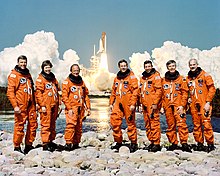|
STS-42
STS-42 was a NASA Space Shuttle Discovery mission with the Spacelab module. Liftoff was originally scheduled for 8:45 EST (13:45 UTC) on January 22, 1992, but the launch was delayed due to weather constraints. Discovery successfully lifted off an hour later at 9:52:33 EST (14:52:33 UTC) on her 14th flight.[1] The main goal of the mission was to study the effects of microgravity on a variety of organisms. The shuttle landed at 8:07:17 PST (16:07:17 UTC) on January 30, 1992, on Runway 22, Edwards Air Force Base, California.[1] STS-42 was the first of two flights in 1992 of Discovery, the second of which occurred during STS-53, which launched on December 2, 1992. The mission was also the last mission of the Space Shuttle Discovery to have a seven-member crew until STS-82, which was launched on February 11, 1997. Crew
The astronauts were divided into a red team and a blue team to allow around-the-clock monitoring of experiments.[2] The crew of STS-42 included the first non-American astronauts on a shuttle mission since the Challenger disaster, Ulf D. Merbold and Roberta Bondar. Merbold was West Germany first astronaut and was making his second flight on the shuttle. Bondar was Canada's first female astronaut. Mary L. Cleave was originally selected to fly as Mission Specialist 3 for this mission but withdrew herself for personal reasons. She was replaced by Manley Lanier "Sonny" Carter Jr., who died seven months prior to the launch in a plane crash. David Hilmers was then chosen to replace him. Backup crew
Crew seat assignments
Mission highlights STS-42 was launched on January 22, 1992, 9:52:33 a.m. EST. The launch was delayed by one hour due to weather constraints. The launch weight was 243,396 lb (110,403 kg). Discovery carried into orbit the International Microgravity Laboratory-1 (IML-1), a pressurized crewed Spacelab module, to explore in depth the complex effects of weightlessness on living organisms and materials processing. The international crew, divided into Red and Blue teams, conducted experiments on the human nervous system's adaptation to low gravity and the effects of microgravity on other life forms such as shrimp eggs, lentil seedlings, fruit fly eggs and bacteria. Low gravity materials processing experiments included crystal growth from a variety of substances such as enzymes, mercury, iodine and a virus. Other payloads included 10 Get Away Special (GAS) canisters, a number of middeck payloads, two Shuttle Student Involvement Program (SSIP) experiments, and an Australian developed ultraviolet telescope Endeavour.[4] Middeck payloads included Gelation of SOLS: Applied Microgravity Research (GOSAMR), Investigations into Polymer Membrane Processing (IPMP) and the Radiation Monitoring Experiment (RME-III). The mission landed on January 30, 1992, 8:07:17 a.m. PST, Runway 22, Edwards Air Force Base, California, after being extended by a day for continued scientific experimentation. The rollout distance was 9,811 ft (2,990 m). The orbiter returned to Kennedy Space Center on February 16, 1992. The landing weight was 218,016 lb (98,890 kg). Mission insigniaThe four stars in the lower blue field and two stars in the upper blue field of the insignia symbolize the flight's numerical designation in the Space Transportation System's mission sequence. The single gold star above the horizon on the right is in honor of astronaut Manley Lanier "Sonny" Carter Jr., who was killed in the crash of Atlantic Southeast Airlines Flight 2311 in Brunswick, Georgia while on a commercial airplane traveling for NASA. Carter was originally assigned as a mission specialist on STS-42 at the time of his death. See also
References
External linksWikimedia Commons has media related to STS-42.
|
||||||||||||||||||||||||||||||||||||||||||||||||||||||||||||||||||||||||||||||||||||||||||||||||||||||||||||||||||||||||||||||||||||||||||||
Portal di Ensiklopedia Dunia




